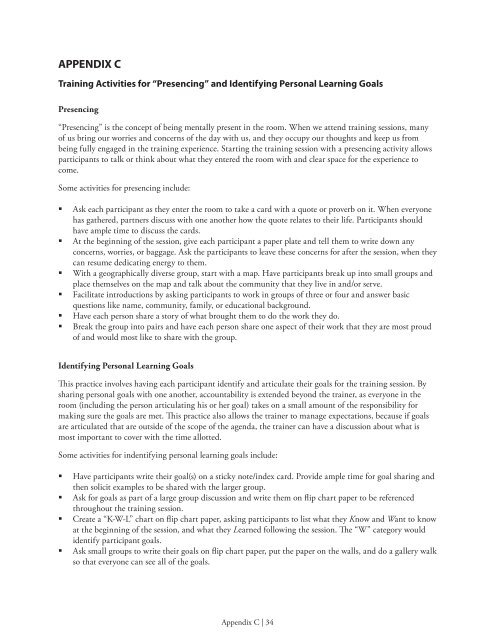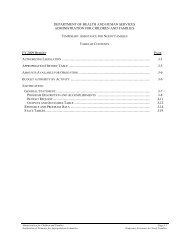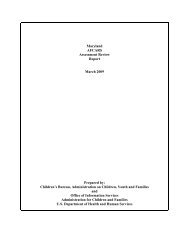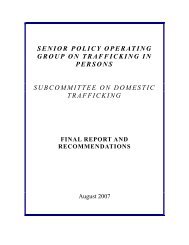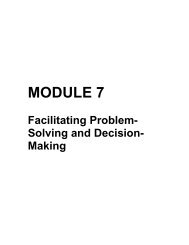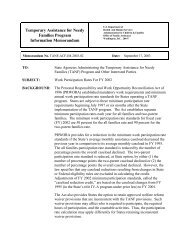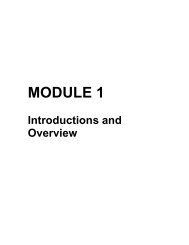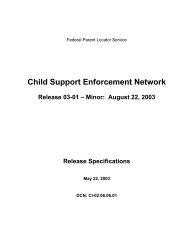Delivering Training and Technical Assistance - Administration for ...
Delivering Training and Technical Assistance - Administration for ...
Delivering Training and Technical Assistance - Administration for ...
You also want an ePaper? Increase the reach of your titles
YUMPU automatically turns print PDFs into web optimized ePapers that Google loves.
APPENDIX C<strong>Training</strong> Activities <strong>for</strong> “Presencing” <strong>and</strong> Identifying Personal Learning GoalsPresencing“Presencing” is the concept of being mentally present in the room. When we attend training sessions, manyof us bring our worries <strong>and</strong> concerns of the day with us, <strong>and</strong> they occupy our thoughts <strong>and</strong> keep us frombeing fully engaged in the training experience. Starting the training session with a presencing activity allowsparticipants to talk or think about what they entered the room with <strong>and</strong> clear space <strong>for</strong> the experience tocome.Some activities <strong>for</strong> presencing include:• Ask each participant as they enter the room to take a card with a quote or proverb on it. When everyonehas gathered, partners discuss with one another how the quote relates to their life. Participants shouldhave ample time to discuss the cards.• At the beginning of the session, give each participant a paper plate <strong>and</strong> tell them to write down anyconcerns, worries, or baggage. Ask the participants to leave these concerns <strong>for</strong> after the session, when theycan resume dedicating energy to them.• With a geographically diverse group, start with a map. Have participants break up into small groups <strong>and</strong>place themselves on the map <strong>and</strong> talk about the community that they live in <strong>and</strong>/or serve.• Facilitate introductions by asking participants to work in groups of three or four <strong>and</strong> answer basicquestions like name, community, family, or educational background.• Have each person share a story of what brought them to do the work they do.• Break the group into pairs <strong>and</strong> have each person share one aspect of their work that they are most proudof <strong>and</strong> would most like to share with the group.Identifying Personal Learning GoalsThis practice involves having each participant identify <strong>and</strong> articulate their goals <strong>for</strong> the training session. Bysharing personal goals with one another, accountability is extended beyond the trainer, as everyone in theroom (including the person articulating his or her goal) takes on a small amount of the responsibility <strong>for</strong>making sure the goals are met. This practice also allows the trainer to manage expectations, because if goalsare articulated that are outside of the scope of the agenda, the trainer can have a discussion about what ismost important to cover with the time allotted.Some activities <strong>for</strong> indentifying personal learning goals include:• Have participants write their goal(s) on a sticky note/index card. Provide ample time <strong>for</strong> goal sharing <strong>and</strong>then solicit examples to be shared with the larger group.• Ask <strong>for</strong> goals as part of a large group discussion <strong>and</strong> write them on flip chart paper to be referencedthroughout the training session.• Create a “K-W-L” chart on flip chart paper, asking participants to list what they Know <strong>and</strong> Want to knowat the beginning of the session, <strong>and</strong> what they Learned following the session. The “W” category wouldidentify participant goals.• Ask small groups to write their goals on flip chart paper, put the paper on the walls, <strong>and</strong> do a gallery walkso that everyone can see all of the goals.Appendix C | 34


